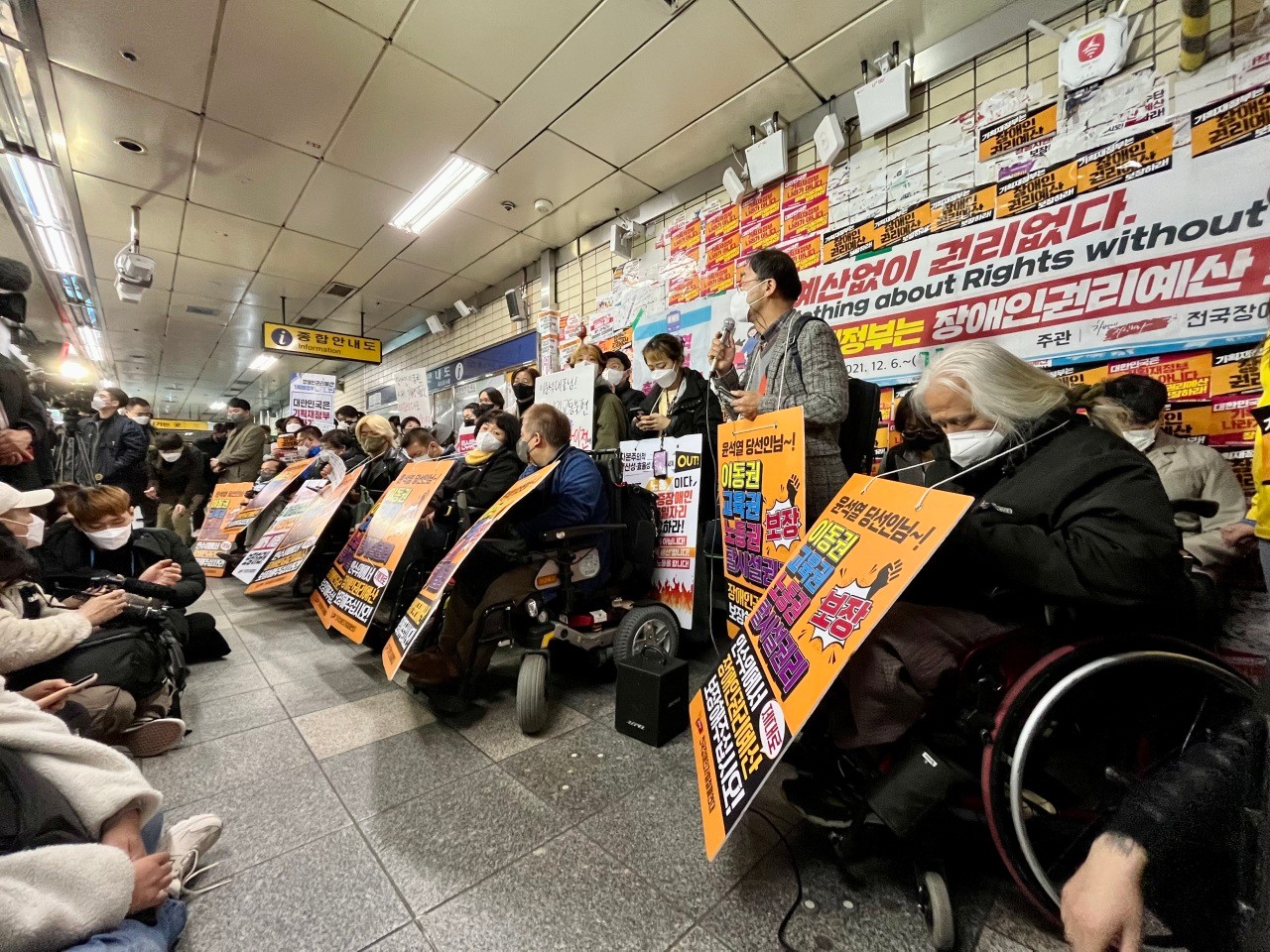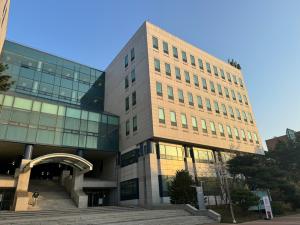Since last December, Solidarity Against Disability Discrimination (SADD), a disability advocacy group, has been staging protests at Seoul subway stations during rush hour. SADD was protesting for the advancement of rights for people with disabilities, but instead of advocating successfully for their cause, the protests drew lots of resentment from non-disabled Koreans. The group was criticized for violating the Assembly and Demonstration Act, the Railroad Safety Act, and the General Obstruction of Traffic Crime law. They raised the ire of passengers by repeatedly getting on and off trains during rush hour, resulting in train delays and more than 1,100 complaints pouring into the Seoul Metro authorities.
 |
| ▲ SAAD Protesting at Seoul Subway for Mobility Rights (Photo from The Korea Herald) |
Mobility rights for people with disabilities have been discussed for more than twenty years. The movement to guarantee mobility rights started in 2001 when a wheelchair lift fell seven meters at Oido Station, killing a third-degree disabled woman in her 70s. After months of protests, the Act on Promotion of the Transportation Convenience of Mobility Disadvantaged Persons, a law that aims to establish a safe transportation system for people with disabilities, was implemented in January 2006. However, people with disabilities still experience inconveniences while using public transportation. As of 2020, only 10 out of 2,278 registered express buses were designated wheelchair accessible, which is about 0.44% of the total, and wheelchair-accessible taxis are problematic since they need to be booked a day in advance.
SADD has set out several requirements to improve the situation. The first is to provide state funding for the operating expenses of special transportation vehicles such as wheelchair-accessible buses. The second is for the Ministry of Economy and Finance to authorize a budget that guarantees up to 24-hour support for people with disabilities. Third, a budget increase for the deinstitutionalization of people with disabilities, from 2.4 billion won (about 2 million dollars) to 622.4 billion won (about 500 million dollars). Deinstitutionalization means state support for people with disabilities to live as autonomous members of the community. However, there are limitations to executing these requirements. First, the Ministry of Health and Welfare states that additional personnel are needed to guarantee 24-hour support. In addition, they said it was difficult to make promises for any budget increases before the progress of the de-facility pilot project is analyzed, since this is its first year. In addition, they pointed out that deinstitutionalization is not something we should take lightly since there are conflicting opinions about the topic among people with disabilities.
The public’s response toward the subway protestors was mixed. Those who stand with them argue that their actions were inevitable and that they were simply a social minority calling for measures to improve their quality of lives. It is important to note that until now, pledges to guarantee mobility rights for people with disabilities have not been kept. Former Seoul mayors pledged to install elevators at all Seoul subway stations since 2004, but only 93.6 percent were installed as of February this year. As mobility rights are directly linked to basic human rights, many agreed that demonstrations were needed to call out the painfully slow progress. The demonstrations also brought the issues faced by people with disabilities to light. Citizens took an interest in mobility rights and SAAD had significant discussions with the National Human Rights Commission of Korea. However, citizens faced major inconveniences when using the subway because of these protests. Many people criticized the organizers for disrupting the morning rush hour and breaking several laws in the process. During the demonstration, some wheelchair users would intentionally put their wheels into the gaps between the train and platform to stop the subway from departing, causing a delay of more than an hour. This is a violation of article 48 of the Railroad Safety Act as the action caused hindrance to the operation of a train. It also violated article 12 of the Assembly and Demonstration Act and the General Obstruction of Traffic Crime. The more the demonstration made it difficult for subway riders to use the train, the more it drew discontent or even hatred from commuters who are dependent on public transportation. Some argued if SAAD’s demands were to be met, other interest groups may carry out similar demonstrations in the future.
The Dankook Herald (DKH) interviewed Professor Jang Soo-jeong and Professor Jeong Chang-ryul from Dankook University (DKU)’s Dept. of Social Welfare to learn more about the issues at stake. Professor Jeong spoke about wheelchair users not being able to take regular buses because of the high stairs needed to board. He said they are forced to wait for low-floor buses, not knowing when the next one will arrive. This adds to the difficulty of going out for those with disabilities. Professor Jang said delays in enforcing the Act on Promotion of the Transportation Convenience of Mobility Disadvantaged Persons, which was amended in December 2021, had spurred protests for SAAD. Professor Jeong pointed out their actions reflected their desperation. He continued saying that even though the government made promises, they were actually passive about improving transportation access for people with disabilities for financial reasons.
 |
| ▲ Lee Joon-seok, head of the People Power Party (left) and Park Kyung-seok, chairperson of SAAD (right), are having a one-on-one discussion on the live broadcast of JTBC show 'Ssulzun.' (Photo from News1) |
The head of the People Power Party, Lee Jun-seok, posted comments on Facebook criticizing the demonstrators saying that, innocent citizens were being held ‘hostage,’ and that minority politics were creating sanctuaries for the ‘Underdogma (a belief that the weak are unconditionally good and the strong are evil).’ Professor Jeong called his comments typical for those with ableism and that according to Lee, SADD blocked the mobility rights of ordinary citizens. However, their protest was for everyone’s benefit, including people who may end up disabled in the future. Instead of simply criticizing their actions, Jeong believes Lee should be actively seeking to resolve their problems. Professor Jang added that Lee was merely focusing on the opinions of the majority to get elected. The sensitivity of the minority is important, but he didn’t need to listen to them to get elected. He used words that stirred the controversy making the problems unclear and the unproductive. Jang concluded that a conversation among stakeholders was necessary as soon as possible.
On March 30, SADD announced a temporary suspension of demonstrations until April 20, after they were able to meet with President-elect Yoon's Transitional Committee. However, they expressed a will to continue to rally support by shaving their heads as a sign of protest at Gyeongbokgung Station every morning until their demands are met. Twenty years after the passing of the Act on Promotion of the Transportation Convenience of Mobility Disadvantaged Persons, there are still many access limitations for people with disabilities and demonstrations may have been the only way to bring attention to their plight. Although there were conflicting opinions among citizens, the government, and SADD, about the methods, it is clear they raised awareness of the issues and forced the discussion on whether social welfare for the socially disadvantaged was being carried out properly. They also highlighted the fact that mobility rights are the issue for everyone in our society. The DKH hopes that measures will be taken to guarantee the rights of people with disabilities, so that every citizen can live in this society without disadvantage.
김혜선, 구시현, 이승준, 이진희 dankookherald@gmail.com






